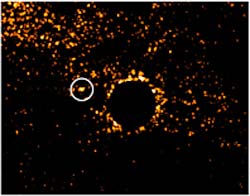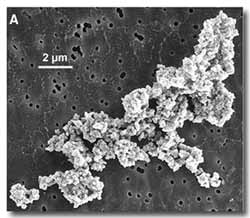Physics and Astronomy
This area deals with the fundamental laws and building blocks of nature and how they interact, the properties and the behavior of matter, and research into space and time and their structures.
innovations-report provides in-depth reports and articles on subjects such as astrophysics, laser technologies, nuclear, quantum, particle and solid-state physics, nanotechnologies, planetary research and findings (Mars, Venus) and developments related to the Hubble Telescope.

Researchers discover carriers of astronomical 2175 extinction line in presolar grains
Turn out the light!
A collaborative team of researchers has discovered what turns the lights out from space. Using sophisticated features on a transmission electron microscope, John P. Bradley, Ph.D., Director of the Institute for Geophysics and Planetary Physics at Lawrence Livermore National Laboratory, has discovered that organic carbon and amorphous silicates in interstellar grains embedded within interplanetary dust particles (IDPs) are the carriers of the astronomical 2175 Å

First Search in Stellar Graveyard Yields Two Possible Planets
Astronomers are announcing today the first results of a search for extrasolar planets and brown dwarfs in an unlikely place–the stellar graveyard. The report, titled “Searching for Extrasolar Planets in the Stellar Graveyard,” is being presented at the American Astronomical Society meeting in San Diego, California, by John Debes, a graduate student at Penn State; Steinn Sigurdsson, associate professor of astronomy and astrophysics at Penn State University; Bruce Woodgate, of the NASA Goddard Spa

LSU researcher solves ancient astronomy mystery
An ancient mystery may have been solved by LSU Associate Professor of Physics and Astronomy Bradley E. Schaefer.
Schaefer has discovered that the long-lost star catalog of Hipparchus, which dates back to 129 B.C., appears on a Roman statue called the Farnese Atlas. Hipparchus was one of the greatest astronomers of antiquity and his star catalog was the first in the world, as well as the most influential. The catalog was lost early in the Christian era, perhaps in the fire at the gr

Spying on Black-Hole Eating Habits with LISA
As big fish eat little fish in the Earth’s vast oceans, so too do supermassive black holes gorge on smaller black holes and neutron stars, making themselves more massive in the process. Using sophisticated computer modeling, Penn State scientists have calculated the rate of this black-hole snacking, called “extreme-mass-ratio inspirals.” They expect to see several events per year with the Laser Interferometer Space Antennae (LISA), a joint NASA – European Space Agency mission now in develop

Organic molecules transport strongest spectral signature of interplanetary dust particles
Carbon and silicate grains in interplanetary dust particles are helping scientists solve a 40-year-old astronomical mystery.
Using a transmission electron microscope, researchers from Lawrence Livermore National Laboratory have detected a 5.7-electron volt or 2175 Å (angstrom) wavelength feature in interstellar grains that were embedded within interplanetary dust particles (IDPs). They found that this feature is carried by carbon and amorphous silicate grains that are abundant in

New view of distant colliding galaxies captured by Keck laser system
For the first time, astronomers have been able to combine the deepest optical images of the universe, obtained by the Hubble Space Telescope, with equally sharp images in the near-infrared part of the spectrum using a sophisticated new laser guide star system for adaptive optics at the W. M. Keck Observatory in Hawaii. The new observations, presented at the American Astronomical Society (AAS) meeting in San Diego this week, reveal unprecedented details of colliding galaxies with massive black hol